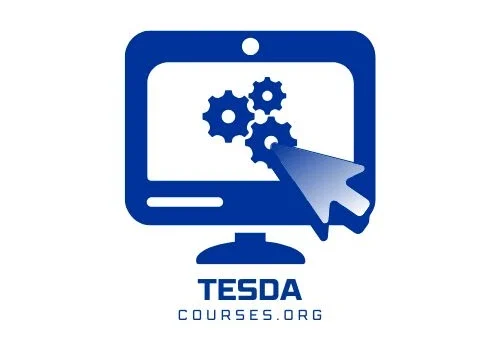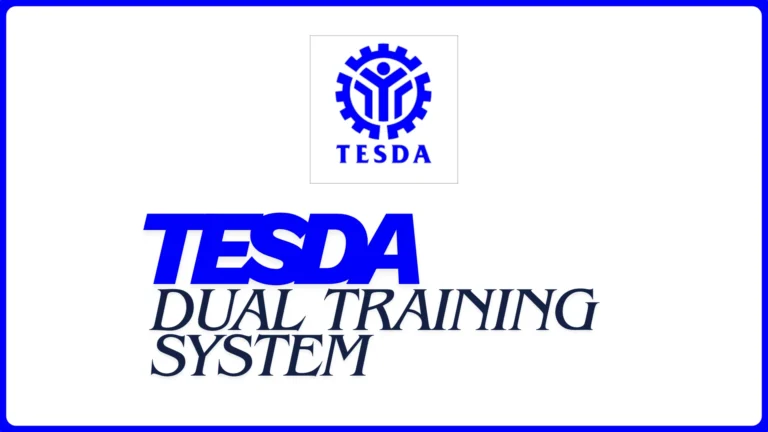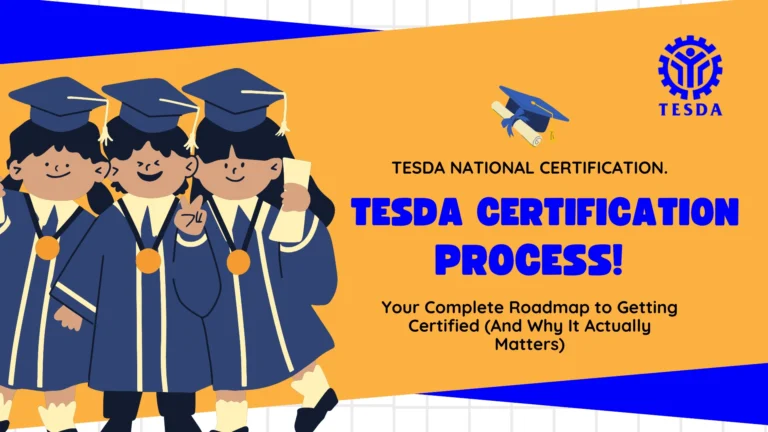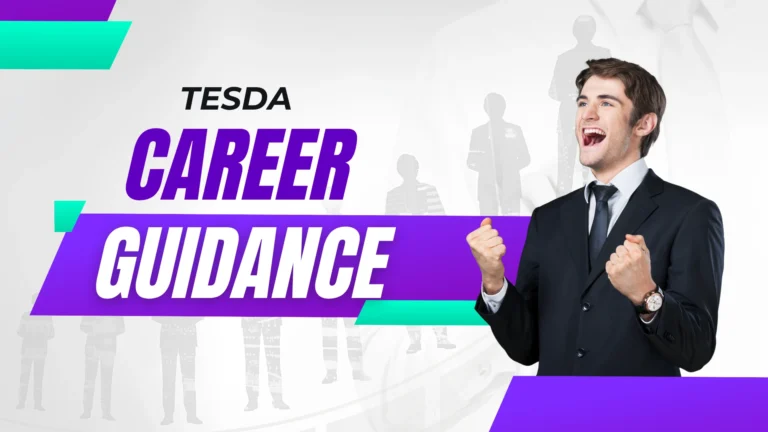TESDA UTPRAS: Your Complete Guide to the Unified TVET Program Registration and Accreditation System
Picture this: You’re ready to enroll in a vocational training program in the Philippines. You’ve researched schools, compared tuition fees, and maybe even stalked their social media pages. But here’s the million-peso question—how do you know if that program is actually legit?
Enter TESDA UTPRAS, or if you want the full mouthful: the Unified TVET Program Registration and Accreditation System. It’s basically TESDA’s way of saying, “We’re bringing order to this chaos, and we’re doing it online.”
Now, I know what you’re thinking. Another government system? Another acronym to memorize? Another online portal that probably looks like it was designed in 2005? But stick with me here—TESDA UTPRAS is actually a game-changer, and understanding it could save you from wasting time and money on programs that aren’t worth the paper their certificates are printed on.
Whether you’re an international student trying to navigate Philippine vocational education, or you’re just curious about how quality control works in TVET (Technical and Vocational Education and Training), this guide will break down everything you need to know about UTPRAS without putting you to sleep.
What Exactly Is TESDA UTPRAS?
Let’s start with the basics, shall we?
TESDA UTPRAS is the Philippines’ centralized online platform for registering and accrediting TVET programs. Think of it as the gatekeeper that determines which programs get the official TESDA stamp of approval and which ones get sent back to the drawing board.
Before UTPRAS came along, the registration and accreditation process was—how do I put this diplomatically?—a bureaucratic nightmare. Paper forms in triplicate. Multiple office visits. Files getting lost in various government desks. It was like trying to navigate a maze while blindfolded and walking backward.
The TESDA UTPRAS system changed all that by moving everything online. Now, training centers can register their programs, submit documents, track application status, and communicate with TESDA officials all through one portal. Revolutionary? Maybe not. Necessary? Absolutely.
The Big Picture
Here’s why UTPRAS matters for everyone involved in vocational education:
For Training Centers:
- Streamlined registration process
- Faster approval times
- Real-time application tracking
- Digital document management
- Easier program renewals
For Students (That’s You!):
- Transparency in program accreditation
- Ability to verify program legitimacy
- Assurance of quality standards
- Protection against bogus institutions
- Access to government scholarships and programs
For Employers:
- Confidence in graduate qualifications
- Standardized training outcomes
- Easy verification of program credentials
- Quality talent pipeline
Understanding TESDA UTPRAS Registration
Let’s talk about TESDA UTPRAS registration—the first major hurdle training centers face.
What Is Program Registration?
Program registration is the initial step where a TVET provider formally notifies TESDA: “Hey, we want to offer this specific training program.” It’s not full accreditation yet (we’ll get to that), but it’s the necessary first step.
Think of it like this: registration is getting your learner’s permit, while accreditation is getting your actual driver’s license.
The TESDA UTPRAS Program Registration Process
Here’s how TESDA UTPRAS program registration actually works:
Step 1: Account Creation Before anything else, training centers need to create a TESDA UTPRAS user account. This isn’t rocket science, but you’d be surprised how many institutions get stuck here. They need:
- Valid institutional email address
- Tax Identification Number (TIN)
- Business registration details
- Authorized signatory information
Step 2: Program Selection Training centers choose which programs they want to register from TESDA’s approved list of Training Regulations. These are standardized curricula for various occupations—everything from caregiving to welding to digital marketing.
Step 3: Document Preparation This is where things get serious. The TESDA UTPRAS document requirements are extensive:
| Document Category | Specific Requirements |
|---|---|
| Institutional Documents | SEC/DTI registration, Business permit, TIN certificate |
| Facility Requirements | Building permits, Fire safety clearance, Sanitation permit |
| Equipment Inventory | Complete list with specifications, Photos, Purchase receipts |
| Trainer Qualifications | Trainer profile, Certifications, Training certificates |
| Training Regulations | Curriculum alignment, Assessment tools, Learning materials |
Step 4: Online Submission Using the TESDA UTPRAS portal, training centers upload all documents and submit their application. The system generates a reference number for tracking—guard this like your Netflix password because you’ll need it.
Step 5: Review and Assessment TESDA evaluators review the submission through the TESDA UTPRAS assessment module. They check:
- Completeness of documentation
- Compliance with training regulations
- Adequacy of facilities and equipment
- Qualifications of trainers
- Financial capability of the institution
Step 6: Site Visit (If Required) Sometimes—especially for new institutions—TESDA conducts a physical inspection. Surprise visits aren’t common, but they happen. It’s like a health inspection for restaurants, except for training centers.
Step 7: Decision and Notification Finally, the decision. Approved applications get a registration certificate valid for a specific period. Denied applications receive feedback on what needs fixing.
TESDA Courses for Abroad: The Ultimate Guide to In-Demand NC II & NC III Certifications
TESDA UTPRAS Accreditation: The Next Level
Now, here’s where things get interesting. TESDA UTPRAS accreditation is the premium certification that separates the good from the great.
Registration vs. Accreditation: What’s the Difference?
I see this confusion constantly, so let’s clear it up:
Registration:
- Basic compliance with standards
- Permission to operate the program
- Minimum requirements met
- Shorter validity period
- Entry-level status
Accreditation:
- Demonstrated excellence
- Higher quality standards
- Proven track record
- Longer validity period
- Premium status benefits
It’s like the difference between a street food cart with a business permit and a restaurant with a Michelin star. Both can operate legally, but one has proven exceptional quality.
The TESDA UTPRAS Accreditation Process
The TESDA UTPRAS accreditation process builds on registration:
Phase 1: Eligibility Check You can’t just jump to accreditation. Training centers need:
- At least one full program cycle completed
- Minimum number of graduates
- Satisfactory performance records
- No major violations or complaints
- Updated registration status
Phase 2: Self-Assessment Centers conduct an internal evaluation using TESDA UTPRAS accreditation criteria:
- Quality of training delivery
- Graduate employment rates
- Assessment pass rates
- Student satisfaction scores
- Industry feedback
- Continuous improvement initiatives
Phase 3: Documentation Enhancement Accreditation requires more robust evidence:
- Graduate tracer studies
- Industry partnerships and MOAs
- Quality management systems
- Student feedback mechanisms
- Trainer professional development records
- Equipment maintenance logs
Phase 4: External Assessment TESDA sends accreditors for comprehensive evaluation. These folks are thorough—think tax audit meets military inspection.
They examine:
- Actual training sessions (surprise observations)
- Graduate employment outcomes
- Equipment functionality and maintenance
- Student satisfaction levels
- Industry partner testimonials
- Quality assurance systems
Phase 5: Accreditation Decision Based on the assessment, programs receive accreditation levels:
| Accreditation Level | Validity Period | Requirements Met |
|---|---|---|
| Level I | 2 years | Basic quality standards exceeded |
| Level II | 3 years | Consistent high quality demonstrated |
| Level III | 4 years | Excellence across all criteria |
| Level IV | 5 years | Outstanding and sustained excellence |
Higher levels mean longer validity, fewer monitoring visits, and greater institutional reputation.
Navigating the TESDA UTPRAS Online Portal
Let me share some hard-earned wisdom about using the TESDA UTPRAS online platform. It’s better than the old system, but it’s not exactly intuitive.
Getting Started
The TESDA UTPRAS official website is your starting point. You’ll need:
- Stable internet connection (this seems obvious, but you’d be surprised)
- Updated web browser (preferably Chrome or Firefox)
- Scanned documents ready in PDF format
- Patience—government systems have their own timeline
Common Portal Features
Dashboard: Your command center showing:
- Application status
- Pending tasks
- Notifications
- Quick links to forms and documents
Application Management: Where you initiate new applications, track progress, and submit additional documents.
Program Registry: Search and verify registered and accredited programs. This is gold for students—use it!
Document Repository: Upload and manage all your supporting documents.
Communication Module: Direct messaging with TESDA evaluators and regional offices.
TESDA UTPRAS Troubleshooting
Because things go wrong. Always.
Problem: Can’t log in
- Clear browser cache and cookies
- Try a different browser
- Check if Caps Lock is on (yes, really)
- Contact the TESDA UTPRAS help desk
Problem: Upload fails
- Check file size (usually max 5MB per file)
- Ensure PDF format (not JPEG of a document)
- Rename file to remove special characters
- Compress large files
Problem: Application stuck in limbo
- Check for pending document requests
- Review email for TESDA communications (check spam folder)
- Contact your regional TESDA office
- Use the portal’s messaging feature
Problem: Form won’t submit
- Fill out ALL required fields (marked with asterisks)
- Validate entries before submission
- Screenshot error messages for support
- Save draft frequently
TESDA Courses for Abroad: The Ultimate Guide to In-Demand NC II & NC III Certifications
TESDA UTPRAS Requirements: The Complete Checklist
Let’s talk about TESDA UTPRAS requirements in detail because this is where most applications stumble.
Institutional Requirements
Legal Documents:
- SEC/DTI registration certificate
- Mayor’s business permit (current year)
- BIR Certificate of Registration
- Tax clearance certificate
- Barangay clearance
Facility Requirements:
- Building/occupancy permit
- Fire safety inspection certificate
- Sanitation permit from health office
- Environmental compliance certificate (if applicable)
- Lease agreement or land title
Physical Facility Standards:
- Adequate classroom space (meets TESDA standards)
- Proper ventilation and lighting
- Clean, safe toilets and water supply
- Emergency exits and fire extinguishers
- Accessible to persons with disabilities
Program-Specific Requirements
Training Regulation Compliance: Each TVET program has specific Training Regulations (TR) that detail:
- Required training hours
- Competencies to be developed
- Assessment methods
- Equipment specifications
- Trainer qualifications
You can’t just wing it—everything must align with the TR for your chosen program.
Equipment and Tools: The TESDA UTPRAS program registration form requires detailed equipment inventory:
- Complete list matching TR requirements
- Equipment specifications and capacities
- Photographs of major equipment
- Proof of ownership (receipts, invoices)
- Maintenance and calibration records
Trainer Requirements
TESDA UTPRAS trainer requirements are non-negotiable:
Minimum Qualifications:
- National Certificate in the trade/specialization
- Trainer’s Methodology Level I certificate
- Relevant work experience (usually 2-5 years)
- Educational background (varies by program)
Additional Credentials:
- Industry certifications
- Professional licenses (where applicable)
- Advanced training certificates
- Teaching experience
Trainer Portfolio: Each trainer needs a complete file with:
- Updated resume
- Copies of certificates
- Employment contract
- Training needs assessment
- Professional development plan
Understanding TESDA Training Regulations in UTPRAS
TESDA training regulations are the backbone of the entire system. Let me break down why they matter.
What Are Training Regulations?
Training Regulations (TRs) are standardized curricula developed through industry consultation. They specify exactly what competencies a graduate should have and how training should be delivered.
Think of TRs as recipes—you can’t just throw random ingredients together and call it lasagna. You follow the recipe, or you end up with something else entirely.
How TRs Work in UTPRAS
When you register a program through TESDA UTPRAS, you’re essentially committing to deliver training according to specific TRs. This includes:
Curriculum Components:
- Units of competency
- Learning outcomes per unit
- Required training hours
- Assessment methods
- Performance criteria
Delivery Requirements:
- Theoretical instruction hours
- Hands-on practice requirements
- Workplace immersion (if required)
- Assessment procedures
- Instructor-to-student ratios
Quality Standards:
- Facility specifications
- Equipment requirements
- Trainer qualifications
- Learning materials standards
- Safety protocols
Aligning Your Program with TRs
This is where many training centers struggle. TESDA UTPRAS program approval depends heavily on TR alignment:
| TR Component | What You Must Demonstrate |
|---|---|
| Competencies | Learning plans cover all required competencies |
| Duration | Training hours meet or exceed minimum requirements |
| Assessment | Assessment tools match TR performance criteria |
| Equipment | All required tools and equipment available |
| Trainers | Qualified to deliver specific competencies |
TESDA UTPRAS Cost and Fees
Let’s talk money because that’s what everyone really wants to know about TESDA UTPRAS cost.
Application Fees
Here’s the thing: TESDA doesn’t charge registration or accreditation fees directly. Zero. Nada. Nothing.
But—and this is a big but—there are indirect costs:
Document Preparation:
- Legal documents: ₱5,000 – ₱15,000
- Permits and clearances: ₱3,000 – ₱10,000
- Professional photos and documentation: ₱2,000 – ₱5,000
Facility Compliance:
- Building improvements: ₱50,000 – ₱500,000+
- Safety equipment: ₱10,000 – ₱50,000
- Furniture and fixtures: ₱30,000 – ₱150,000
Equipment Acquisition:
- Program-specific equipment: ₱100,000 – ₱2,000,000+
- Tools and instruments: ₱50,000 – ₱300,000
- Maintenance and calibration: ₱10,000 – ₱50,000 annually
Trainer Development:
- Trainer’s Methodology courses: ₱5,000 – ₱15,000 per trainer
- Technical competency training: ₱10,000 – ₱50,000 per trainer
- Industry certifications: ₱5,000 – ₱30,000 per certification
Professional Services:
- Consultants: ₱20,000 – ₱100,000
- Legal services: ₱10,000 – ₱50,000
- Documentation support: ₱5,000 – ₱25,000
Ongoing Compliance Costs
Registration and accreditation aren’t one-time expenses:
Annual Requirements:
- Permit renewals: ₱5,000 – ₱15,000
- Equipment maintenance: ₱20,000 – ₱100,000+
- Trainer updates: ₱10,000 – ₱30,000
- Quality monitoring: ₱5,000 – ₱20,000
TESDA UTPRAS Program Monitoring and Renewal
Getting registered or accredited isn’t the finish line—it’s just the starting gun. Let’s talk about TESDA UTPRAS program monitoring.
Continuous Monitoring
TESDA doesn’t register programs and forget about them. The TESDA UTPRAS training program monitoring system includes:
Regular Reporting: Training centers submit periodic reports on:
- Student enrollment numbers
- Graduate data and outcomes
- Trainer updates
- Equipment status changes
- Any operational issues
Site Visits: TESDA conducts monitoring visits, either:
- Scheduled (you get advance notice)
- Unannounced (surprise!)
- Complaint-driven (when someone reports an issue)
Performance Indicators: TESDA tracks key metrics:
- Assessment pass rates
- Graduate employment rates
- Program completion rates
- Compliance with standards
- Student satisfaction
The Renewal Process
TESDA UTPRAS program renewal is required before your registration or accreditation expires.
Timeline:
- Start renewal process 3-6 months before expiry
- Don’t wait until the last minute (seriously, don’t)
- Expired registration = you can’t operate legally
Renewal Requirements:
- Updated institutional documents
- Recent permits and clearances
- Program performance reports
- Graduate tracer study results
- Updated trainer credentials
- Equipment inventory verification
- Continuous improvement evidence
Simplified Process: If you’ve maintained good standing:
- Less documentation required
- Faster processing
- May skip site visit
- Streamlined assessment
Red Flags That Complicate Renewal:
- Multiple student complaints
- Low assessment pass rates
- Unaddressed violations
- Poor graduate employment
- Expired trainer certifications
- Equipment deficiencies
For International Students: Using UTPRAS to Your Advantage
Here’s where this gets practical for you as an international student.
Verifying Program Legitimacy
Before you commit thousands of dollars to a training program, use TESDA UTPRAS to verify:
Step 1: Search the Registry The TESDA UTPRAS program list is publicly searchable:
- Go to the TESDA official website
- Access the UTPRAS registry
- Search by institution name or program
- Check registration/accreditation status
Step 2: Verify Details Look for:
- Current registration/accreditation (not expired)
- Specific program you’re interested in (not just institutional registration)
- Accreditation level (higher is better)
- Validity period
Step 3: Cross-Reference
- Match institution details with their marketing materials
- Verify address and contact information
- Check if they’re advertising programs they’re not registered for
Red Flags to Watch For
Warning signs of questionable programs:
- Refuses to show TESDA registration certificate
- Claims “accreditation pending” for extended periods
- Registered for different program than they’re advertising
- Expired registration or accreditation
- Not found in UTPRAS registry at all
- Vague or evasive about accreditation status
Questions to Ask Training Centers
Be that annoying but smart student who asks:
- “What’s your UTPRAS registration number?”
- “When does your current accreditation expire?”
- “What accreditation level do you hold?”
- “Can I see your TESDA certificate?”
- “Are you registered for this specific program?”
- “When was your last TESDA monitoring visit?”
- “What were the results?”
Legitimate institutions will answer proudly. Sketchy ones will dodge or deflect.
TESDA UTPRAS Updates and Changes
The system keeps evolving. Here are recent TESDA UTPRAS updates you should know about:
Digital Transformation Initiatives
TESDA continues improving the TESDA UTPRAS system:
Recent Enhancements:
- Mobile-responsive portal design
- Improved document upload system
- Real-time application tracking
- Automated reminder notifications
- Enhanced search functionality
Coming Soon:
- Integration with other government databases
- AI-assisted document verification
- Virtual site visit capabilities
- Blockchain-based credential verification
- Student feedback integration
Policy Updates
Recent Changes:
- Streamlined renewal process for compliant institutions
- New training regulations for emerging industries
- Enhanced trainer qualification requirements
- Updated equipment standards for technology programs
- Stricter monitoring for underperforming programs
COVID-19 Adaptations
The pandemic forced TESDA to adapt:
- Online and blended learning provisions
- Modified assessment procedures
- Flexible compliance for temporarily affected institutions
- Digital documentation acceptance
- Remote monitoring options
These changes are becoming permanent features, not just temporary measures.
Getting Help: TESDA UTPRAS Support Resources
Stuck? Confused? Don’t know where to start? Here’s where to get TESDA UTPRAS help.
Official Support Channels
TESDA UTPRAS Help Desk:
- Email support for technical issues
- Response time: usually 2-3 business days
- Available for portal problems and clarifications
Regional TESDA Offices:
- Face-to-face assistance
- Program-specific guidance
- Document review and feedback
- Training and orientation sessions
TESDA Hotline:
- General inquiries
- Application status updates
- Complaint filing
- Information requests
Online Resources
TESDA UTPRAS Manual: The TESDA UTPRAS manual PDF is your bible:
- Comprehensive step-by-step instructions
- Detailed requirement explanations
- Sample documents and templates
- FAQ section
- Contact directory
TESDA UTPRAS User Guide: Simpler than the manual, perfect for beginners:
- Quick start instructions
- Common scenarios and solutions
- Troubleshooting tips
- Video tutorials (when available)
Webinars and Training: TESDA regularly conducts:
- Orientation for new applicants
- Updates on system changes
- Best practice sharing sessions
- Q&A opportunities
Unofficial but Helpful
Facebook Groups: TVET provider communities where people share:
- Real experiences
- Tips and tricks
- Document templates
- Moral support
Consultants and Service Providers: Professional help for:
- Application preparation
- Document compilation
- Compliance gap analysis
- Training regulations interpretation
Just be sure they’re legitimate and experienced.
Common UTPRAS Challenges and Solutions
Let me share some real-world problems and practical solutions:
Challenge 1: Document Rejection
Problem: Your carefully prepared documents get rejected for “non-compliance.”
Solutions:
- Read rejection comments carefully—they tell you exactly what’s wrong
- Compare your documents against the manual specifications
- Ask your regional office for samples or templates
- Ensure document dates are current (expired clearances are common culprits)
- Check file formats and sizes meet requirements
Challenge 2: Trainer Qualification Gaps
Problem: Your trainers don’t meet all requirements.
Solutions:
- Enroll trainers in Trainer’s Methodology courses immediately
- Arrange for National Certification assessment
- Hire additional trainers with proper qualifications
- Partner with industry experts as guest trainers
- Develop a trainer development timeline and share with TESDA
Challenge 3: Equipment Shortfalls
Problem: You don’t have all required equipment yet.
Solutions:
- Prioritize essential equipment first
- Explore equipment leasing options
- Partner with industry for equipment access
- Apply for grants and subsidies
- Present a phased acquisition plan with timeline
Challenge 4: Application Processing Delays
Problem: Your application seems stuck forever.
Solutions:
- Check the TESDA UTPRAS program status check feature regularly
- Respond promptly to any requests for clarification
- Follow up politely through proper channels
- Ensure your contact information is updated
- Visit your regional office if delay is excessive
Challenge 5: Compliance Maintenance
Problem: Maintaining compliance after registration is overwhelming.
Solutions:
- Create annual compliance calendar with reminders
- Assign compliance officer or team
- Set up systematic document management
- Conduct internal audits quarterly
- Stay updated on TESDA announcements
Best Practices for UTPRAS Success
Here’s the insider knowledge that makes everything smoother:
Before You Apply
Do Your Homework:
- Download and study the TESDA UTPRAS manual thoroughly
- Attend TESDA orientation sessions
- Visit successfully registered institutions
- Calculate realistic costs
- Assess your actual readiness
Get Organized:
- Create a master checklist of all requirements
- Establish a document filing system
- Digitize everything (with backups!)
- Assign responsibilities clearly
- Set realistic timelines
During Application
Communication is Key:
- Respond to TESDA queries within 24-48 hours
- Keep communication professional and documented
- Ask for clarification when confused
- Update contact information immediately if it changes
- Use the portal messaging system for official communication
Quality Over Speed:
- Don’t rush the application
- Double-check everything before submission
- Have someone else review your documents
- Ensure photos are clear and properly labeled
- Complete forms accurately and thoroughly
After Approval
Stay Compliant:
- Implement robust quality management systems
- Maintain all standards continuously
- Keep documentation updated
- Address issues proactively
- Prepare for monitoring visits as if they’re tomorrow
Aim Higher:
- If registered, work toward accreditation
- If accredited at Level I, aim for Level II
- Continuously improve facilities and equipment
- Invest in trainer development
- Build strong industry partnerships
The Future of TESDA UTPRAS
Where is this system headed? Here are my observations and predictions:
Technology Integration
Expect more:
- Artificial intelligence for document verification
- Blockchain for credential security
- Mobile applications for easier access
- Virtual reality for remote assessments
- Data analytics for performance tracking
Standardization and Harmonization
TESDA is working toward:
- ASEAN mutual recognition of qualifications
- International standards alignment
- Industry 4.0 competency integration
- Green skills and sustainability focus
- Digital literacy across all programs
Enhanced Quality Assurance
Coming improvements:
- More rigorous accreditation criteria
- Graduate outcome tracking systems
- Employer satisfaction metrics
- Real-time quality monitoring
- Performance-based incentives and penalties
Practical Tips for International Students
Let me wrap up with specific advice for you:
Before Choosing a Program
Research Checklist:
- [ ] Verify TESDA UTPRAS registration status
- [ ] Check accreditation level and validity
- [ ] Read graduate reviews and testimonials
- [ ] Visit facilities in person if possible
- [ ] Verify graduate employment rates
- [ ] Confirm program duration and costs
- [ ] Check if program aligns with your career goals
During Your Studies
Maximize Your Experience:
- Understand the competencies you’re supposed to master
- Practice beyond minimum requirements
- Build relationships with instructors
- Seek industry exposure opportunities
- Document your learning journey
- Prepare seriously for competency assessment
After Graduation
Leverage Your Credentials:
- Obtain your National Certificate promptly
- Keep copies of all certifications
- Register with relevant professional bodies
- Continue skills upgrading
- Network with alumni and industry contacts
- Consider pathway to higher qualifications
Final Thoughts: Why UTPRAS Matters
Here’s the bottom line: TESDA UTPRAS isn’t just another government system or bureaucratic hoop to jump through. It’s actually a quality assurance mechanism that protects students, elevates standards, and gives TVET credentials real value.
For international students, understanding UTPRAS gives you power—the power to make informed decisions, avoid substandard programs, and invest your time and money wisely.
For training institutions, UTPRAS provides a clear roadmap to excellence and a level playing field where quality wins.
The system isn’t perfect. The portal sometimes glitches. The process can be frustrating. Documentation requirements feel excessive. But the alternative—a Wild West of unregulated training programs with zero quality control—is far worse.
As vocational education becomes increasingly important in the global economy, systems like UTPRAS will only become more critical. The Philippines is actually ahead of the curve in many ways with this centralized, transparent approach.
Whether you’re researching programs, managing a training center, or just curious about quality assurance in TVET, understanding UTPRAS helps you navigate the landscape with confidence.
Take Action
For Prospective Students: Visit the TESDA website today and search the TESDA UTPRAS registry for programs you’re considering. Verify. Confirm. Ask questions. Make informed choices.
For Training Providers: If you haven’t started your UTPRAS journey, what are you waiting for? Download the manual, assess your readiness, and begin the process. Quality credentials matter more than ever.
For Everyone: Share this guide with anyone navigating Philippine vocational education. Knowledge is power, and informed choices lead to better outcomes.
Got questions about specific TESDA UTPRAS procedures? Drop them in the comments—I love talking about this stuff, and your question might help someone else too.
Remember: In a world full of questionable credentials and diploma mills, TESDA UTPRAS is your assurance of legitimate, quality vocational education. Use it wisely.
Word Count: ~5,800 words
Disclaimer: TESDA policies and UTPRAS procedures are subject to updates. Always verify current requirements through official TESDA channels and your regional office.







